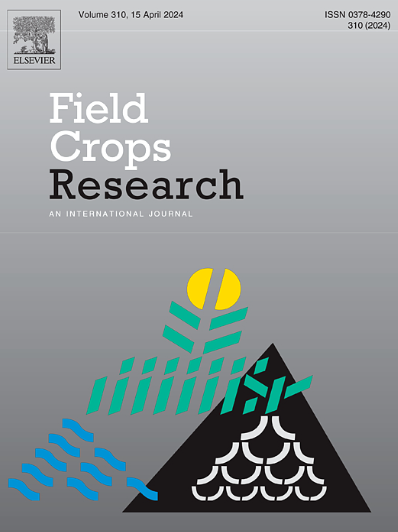Optimizing chemical topping in cotton: Effects of planting density and variety sensitivity to mepiquat chloride
IF 5.6
1区 农林科学
Q1 AGRONOMY
引用次数: 0
Abstract
Context
Chemical topping using plant growth regulators like mepiquat chloride (DPC) effectively inhibits apical dominance in cotton. However, the effectiveness of chemical topping may vary depending on planting density and the sensitivity of cotton varieties to DPC, which remains unclear.
Methods
A split-plot factorial AB+C design field experiment was conducted to evaluate the effects of variety, planting density, topping method, and their interactions on cotton agronomic traits, canopy structure, and yield. The main A plots included cotton varieties with different DPC sensitivities (insensitive and sensitive), main B plots included low, medium, and high planting density (PD14, 14 plants m−2, PD28, 28 plants m−2 and PD55, 55 plants m−2), while subplots were assigned no topping, manual topping (remove of the main-stem tips), and chemical topping (A mixed liquor with 180 g ha−1 mepiquat chloride and 150 ml ha−1 special additives).
Results
In DPC-insensitive varieties, plant height and number of main stem internodes decreased with the increasing plant density, while sensitive varieties showed no significant changes. Sensitive varieties exhibited stronger inhibition of plant height, plant width, and internode length (1.8–35.9 %) than insensitive ones. At medium and low densities, upper internodes in sensitive varieties were reduced by 14.7–43.2 %. At high density, an increased leaf area index (LAI) in sensitive varieties before topping improved light interception rate (LIR). This effect was further enhanced LIR at medium and low densities by sustaining a higher LAI. Compared with manual topping, seed cotton yield increased by 8.7–29.5 % with no topping and by 4.4–33.3 % with chemical topping at low density for both sensitive and insensitive varieties. At medium density, seed cotton yield in sensitive varieties with no topping increased significantly by 6.3–14.6 % under no topping. At high density, the highest seed cotton yield in sensitive varieties was observed with no topping compared with manual or chemical topping. Yield improvements in insensitive varieties under chemical topping were linked to a higher harvest index at medium and high densities, whereas in sensitive varieties, yield increases were driven by a higher total number of bolls per unit area at high density.
Conclusions
Chemical topping with DPC can be a substitute for manual topping at moderate or high planting density in DPC-insensitive varieties, provided systematic chemical control establishes a balanced canopy structure prior to topping. For DPC-sensitive varieties, no topping or continued low-dose chemical control with DPC is recommended for optimal topping effects. These findings provide valuable insights into optimizing chemical topping strategies by considering cotton variety sensitivity to DPC.
棉花化学打顶优化:种植密度和品种对氯吡菊酯敏感性的影响
化学打顶使用植物生长调节剂如甲草枯氯(DPC)能有效抑制棉花的顶端优势。然而,化学打顶的效果可能因种植密度和棉花品种对DPC的敏感性而异,这一点目前尚不清楚。方法采用分区析因AB+C设计田间试验,评价品种、种植密度、打顶方式及其互作对棉花农艺性状、冠层结构和产量的影响。主要A样地包括不同DPC敏感性(不敏感和敏感)的棉花品种,主要B样地包括低、中、高种植密度(PD14, 14株m−2,PD28, 28株m−2和PD55, 55株m−2),子样地不打顶、人工打顶(去除主茎尖)和化学打顶(180 g ha−1氯化物和150 ml ha−1特殊添加剂的混合液)。结果dpc不敏感品种株高和主茎节间数随密度的增加而降低,而dpc不敏感品种变化不显著。敏感品种对株高、株宽和节间长的抑制作用强于不敏感品种(1.8 ~ 35.9 %)。在中低密度下,敏感品种的上节间减少14.7 ~ 43.2 %。在高密度条件下,敏感品种采前叶面积指数(LAI)的提高提高了光截获率(LIR)。这种效应通过维持较高的LAI进一步增强了中、低密度下的LIR。与人工打顶相比,低密度不打顶和化学打顶分别增产8.7 ~ 29.5% %和4.4 ~ 33.3% %。中密度条件下,不打顶敏感品种籽棉产量显著提高6.3 ~ 14.6 %。在高密度条件下,与人工打顶和化学打顶相比,不打顶对敏感品种籽棉产量最高。在化学打顶条件下,不敏感品种的产量提高与中高密度条件下较高的收获指数有关,而敏感品种的产量提高则与高密度条件下较高的单位面积铃数有关。结论在对DPC不敏感的品种中,如果在打顶前有系统的化学控制,建立平衡的冠层结构,DPC化学打顶可替代人工打顶。对于DPC敏感品种,建议不打顶或继续用DPC进行低剂量化学防治,以获得最佳打顶效果。这些研究结果为考虑棉花品种对DPC的敏感性来优化化学打顶策略提供了有价值的见解。
本文章由计算机程序翻译,如有差异,请以英文原文为准。
求助全文
约1分钟内获得全文
求助全文
来源期刊

Field Crops Research
农林科学-农艺学
CiteScore
9.60
自引率
12.10%
发文量
307
审稿时长
46 days
期刊介绍:
Field Crops Research is an international journal publishing scientific articles on:
√ experimental and modelling research at field, farm and landscape levels
on temperate and tropical crops and cropping systems,
with a focus on crop ecology and physiology, agronomy, and plant genetics and breeding.
 求助内容:
求助内容: 应助结果提醒方式:
应助结果提醒方式:


